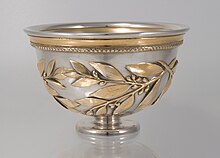Th. Flower
| Th. Flower
|
|
|---|---|
| legal form | GmbH |
| founding | August 31, 1858 |
| Seat | Hildesheim |
| management | Beryl flower |
| Branch | Gold and silversmiths |
| Website | https://th-blume.de/ |
Th. Blume is a jewelry store in Hildesheim with its own workshop in Listringen and a fifth generation family business . The origins and history of the traditional house are closely linked to the cultural and urban history of Hildesheim.
history

On August 31, 1858, Theodor Blume founded his business in the Schuhstrasse in Hildesheim as a jeweler for gold and silver work. In 1868 he bought the half-timbered house on Hohen Weg next to St. Andrew's Church, which was built in the 16th century . Since then, St. Andrew has graced his business seal . As a craft business, utility devices were made from silver here.
From 1906, Blum's second son Hermann took over the workshop. He set priorities in the manufacture of jewelry and also specialized in the reproduction of historical metalwork. The so-called Hildesheim silver find , an extensive collection of Roman table silver from the 1st century AD, which was found during earthworks in 1868, played an important role . He made replicas of them and delivered complete sets of them to various museums and to the Prussian Crown Prince . Other replicas made by Blume were, for example, the Egyptian cat statue from the Pelizaeus Museum , the Clausthaler Bergkanne from 1710 and, above all, the Bernward chandelier from the cathedral treasury . Some of these pieces are still in demand today.
In 1931 the company was taken over in the third generation by Theo Blume, the grandson of the company founder. He had completed his studies as a freelance sculptor , intensified the workshop operations and developed new forms. Individual pieces as well as draft drawings and photographs have survived from this period.
As a result of the Second World War , the company reduced its activities until the workshop was closed in 1944. The half-timbered house burned down after a bomb attack in 1945. The brothers Theo and Heinrich Blume built a new commercial building on the same site, which was completed in 1954.
Since then, the focus in the workshop has been on the production of individual one-off pieces with a stylistic orientation towards current art developments. Another focus was the production of special table silver such as hand-operated drinking cups, which became known beyond Hildesheim.
In 1975 Thore Blume took over the management of the workshop and the artistic design from his father. As a silversmith, he developed a clear and plastic design language derived from nature, whereby precious stones were also incorporated into the design of the jewelry.
After Heinrich Blume's death in 1983, Jochen Blume joined the management team. After Theo Blume died in 1986, he ran it together with Thore Blume.
Beryl Blume has been working in the family business in the fifth generation since 2007 and has been managing director since Thore Blume's death in 2017, supported by Jochen Blume. She continues the craft and design tradition in the style of her father together with the master Christopher Decker. The company is a training company.
Web links
Individual evidence
- ^ Register court: Hildesheim district court, register number: 11 HRB 429
- ^ Art in public space in Hildesheim since 1970. (PDF) In: Kulturium.de - Culture in the Hildesheim region. KulturBüro / Landkreis Hildesheim, pp. 08, 57, 110, 112 , accessed on April 27, 2020 .
- ^ Ring of honor of the city of Hildesheim for special merits. In: Hildesheim City Museum. Retrieved April 27, 2020 .
- ^ City of Hildesheim: Ring of honor of the city of Hildesheim. Manufacturer. In: https://www.hildesheim.de/ . City Archives, accessed on May 2, 2020 .
- ↑ a b c d e f g Susanna Partsch: General Artists Dictionary (AKL) . tape 11 . KGSaur Verlag, Munich / Leipzig 1995, ISBN 978-3-598-22751-6 , p. 634 .
- ↑ a b Boetzkes, Manfred., Erdrich, Michael .: The Hildesheim silver find: original and replica; from Roman treasure to civic pride; [Catalog for the exhibition of the same name in the city museum in the bone hauer-Amtshaus, Hildesheim from July 20 to November 30, 1997; an exhibition by the Roemer Museum Hildesheim in cooperation with the Staatliche Museen zu Berlin, Antikensammlung] . Gerstenberg, Hildesheim 1997, ISBN 3-8067-8552-X .
- ↑ Markus C. Blaich: The Hildesheim silver find from 1868 - reflections on its environment . In: News from Lower Saxony's prehistory . tape 87 , no. 183-197 . Konrad Theiss Verlag, Darmstadt 2018, p. 183 ( academia.edu ).
- ↑ a b Martina Prante: Not everything that glitters is an original: the secret of the silver treasure remains. (PDF) Hildesheimer Allgemeine Zeitung, October 18, 2018, accessed on May 2, 2020 .
- ^ Roemer-Pelizaeus Museum: HIGHLIGHTS & CURIOSITIES. Retrieved May 1, 2020 .
- ↑ Th. Blume, goldsmith, Hildesheim: Der Hildesheimer Silberfund. The Hildesheim Treasure as marks of honor the province Hanover for the wedding of the German Crown Prince on June 6, 1905. Dr. Trenkler & Co., Graphic Art Institute, Leipzig-Stötteritz.
- ↑ Friedrich Balck: The glass Upper Harz mountain jug from 1696 . Oberharzer Geschichts- und Museumsverein eV, Clausthal-Zellerfeld 2001, p. 41, 44 , doi : 10.21268 / 20140612-234205 .
- ↑ Lecture "The replicas of the Upper Harz mountain jug and their creation". Retrieved May 7, 2020 .


